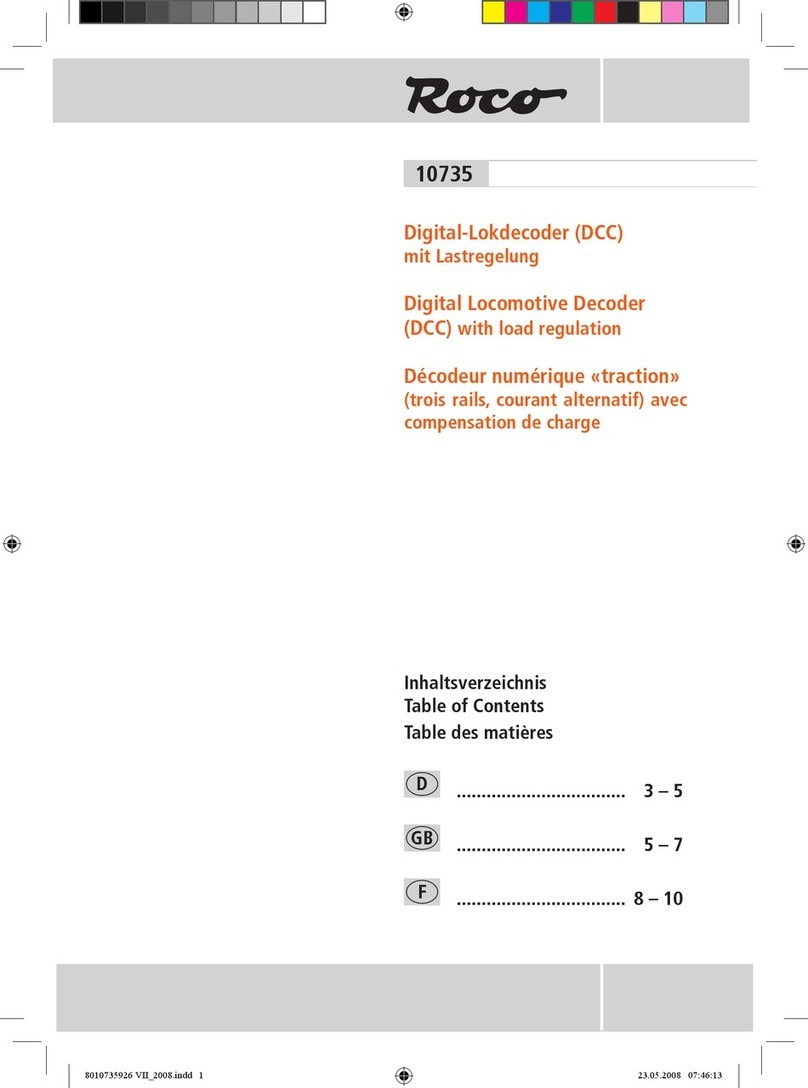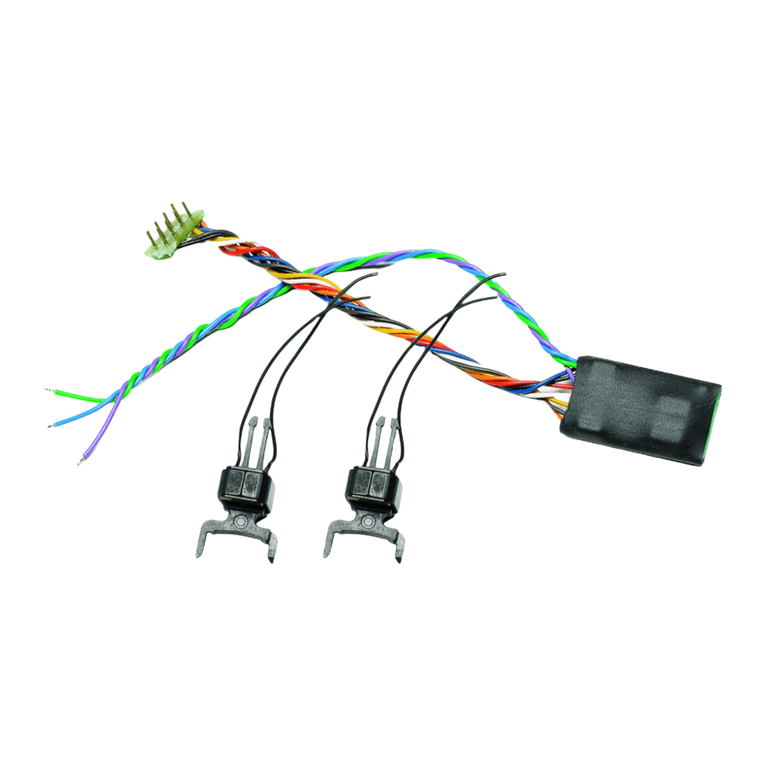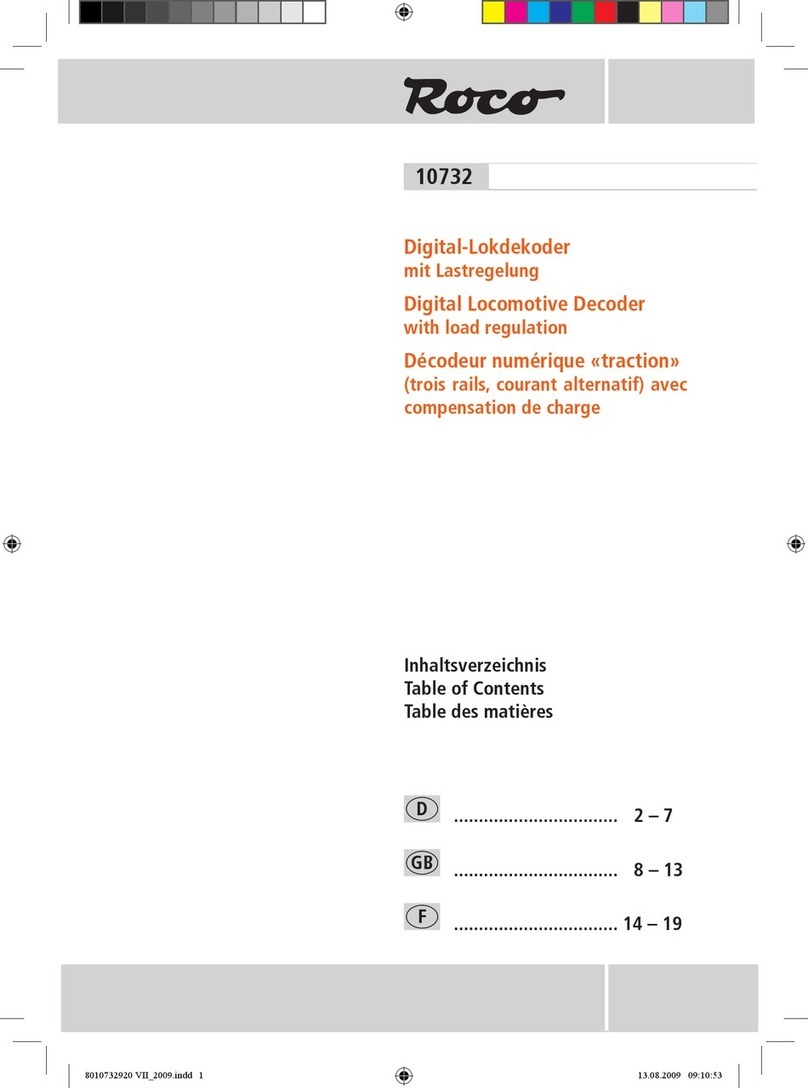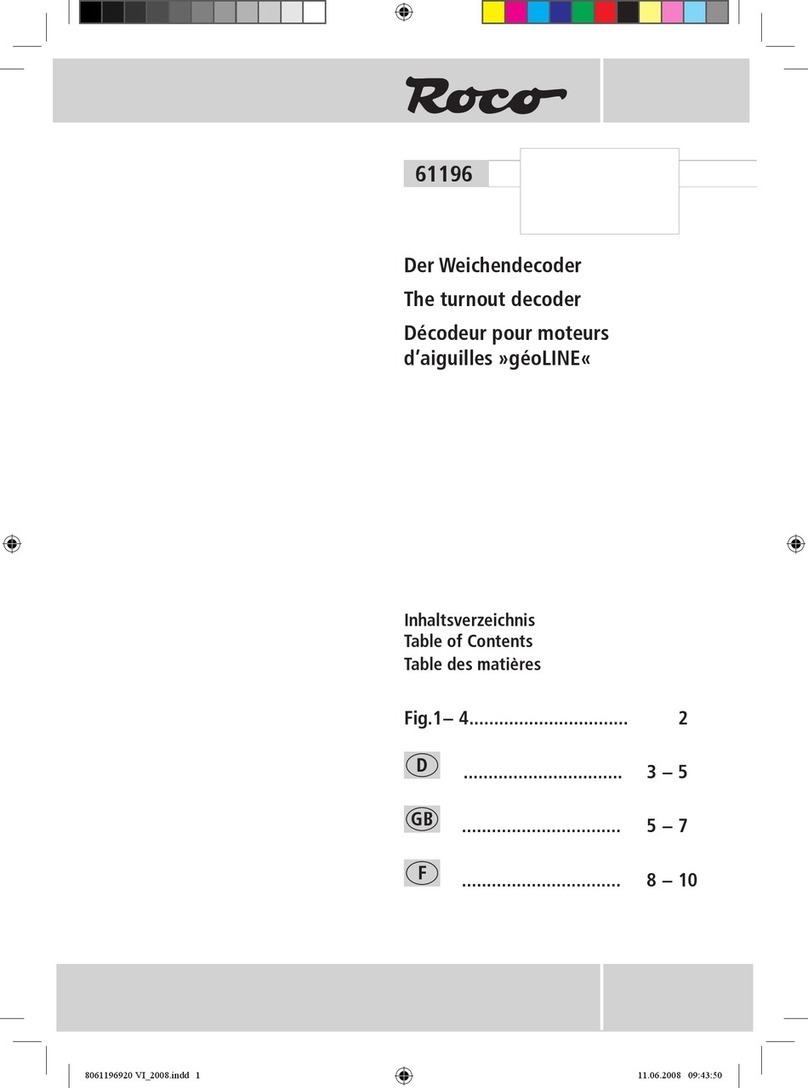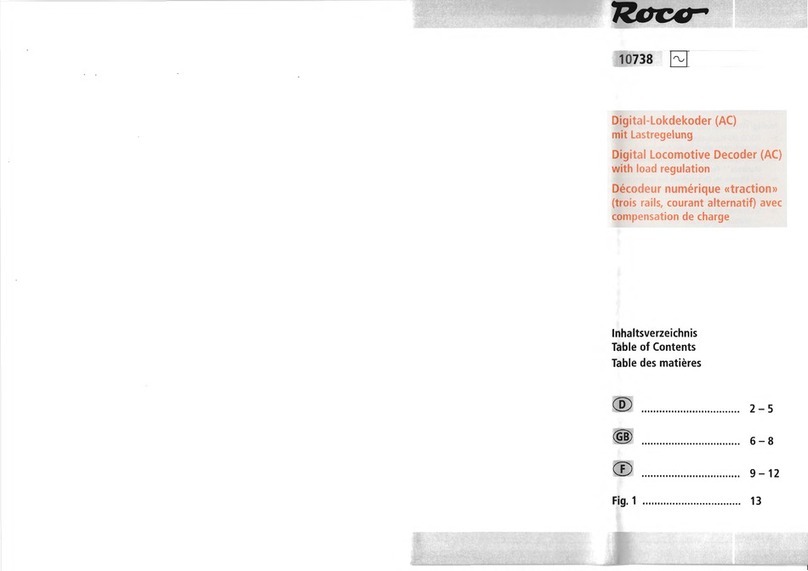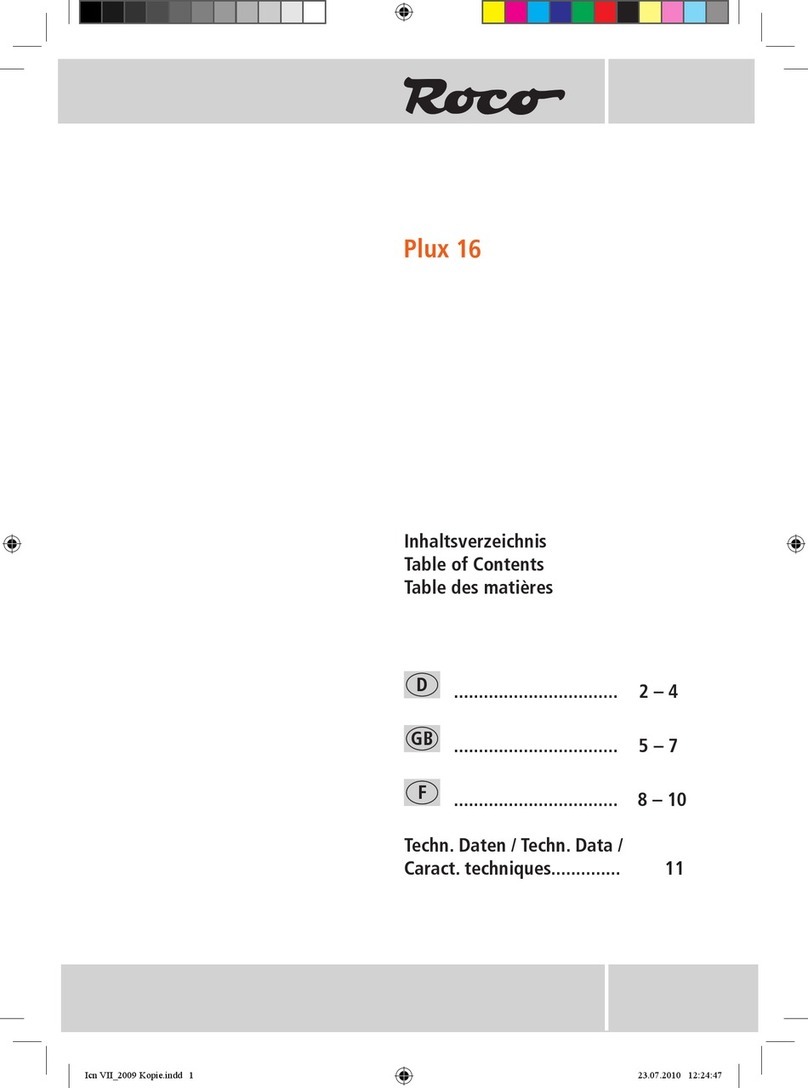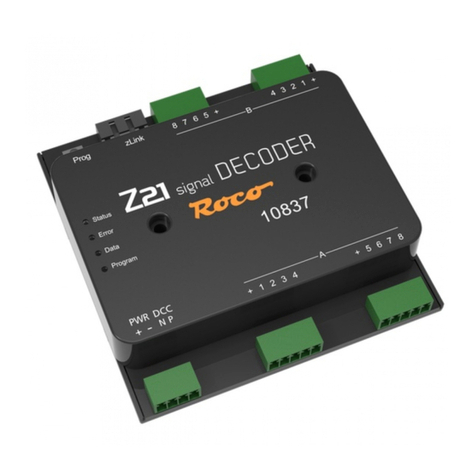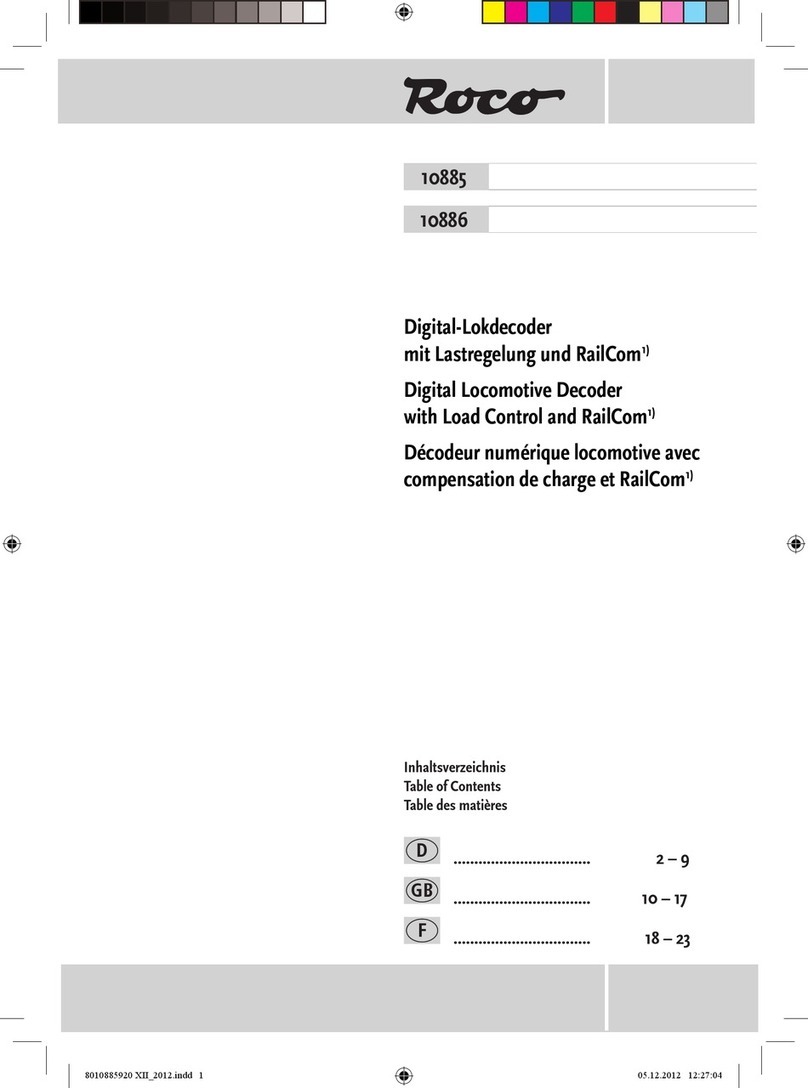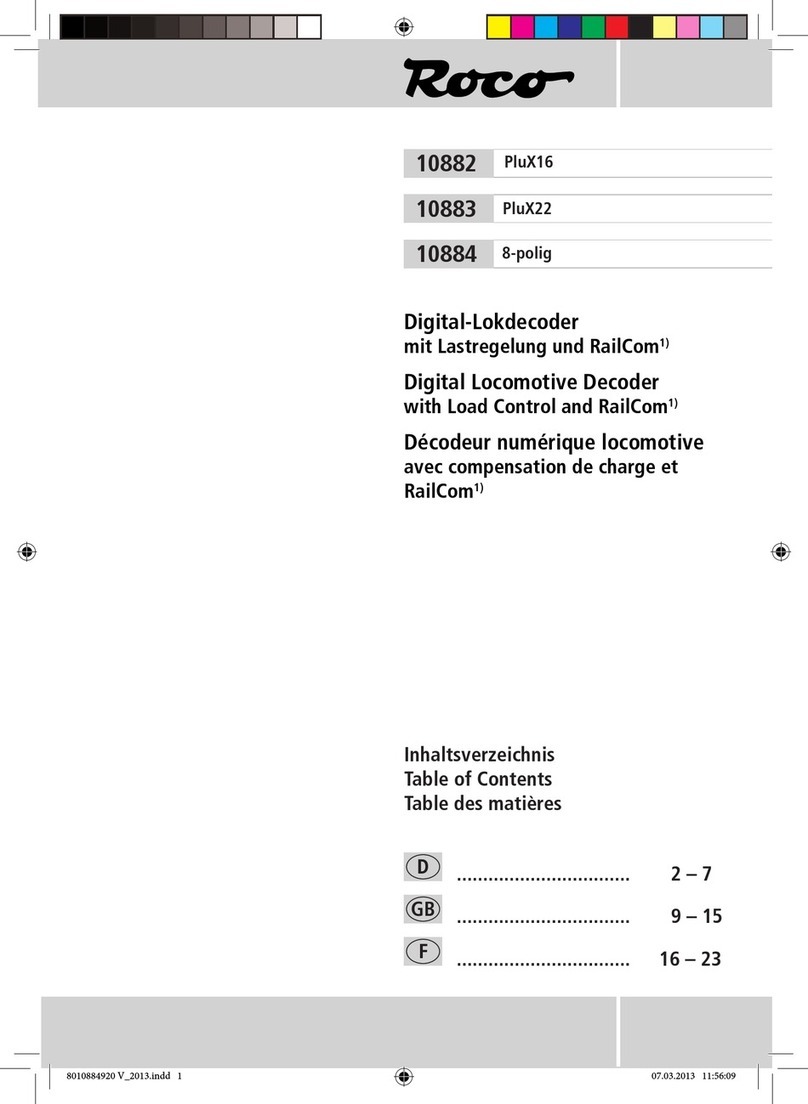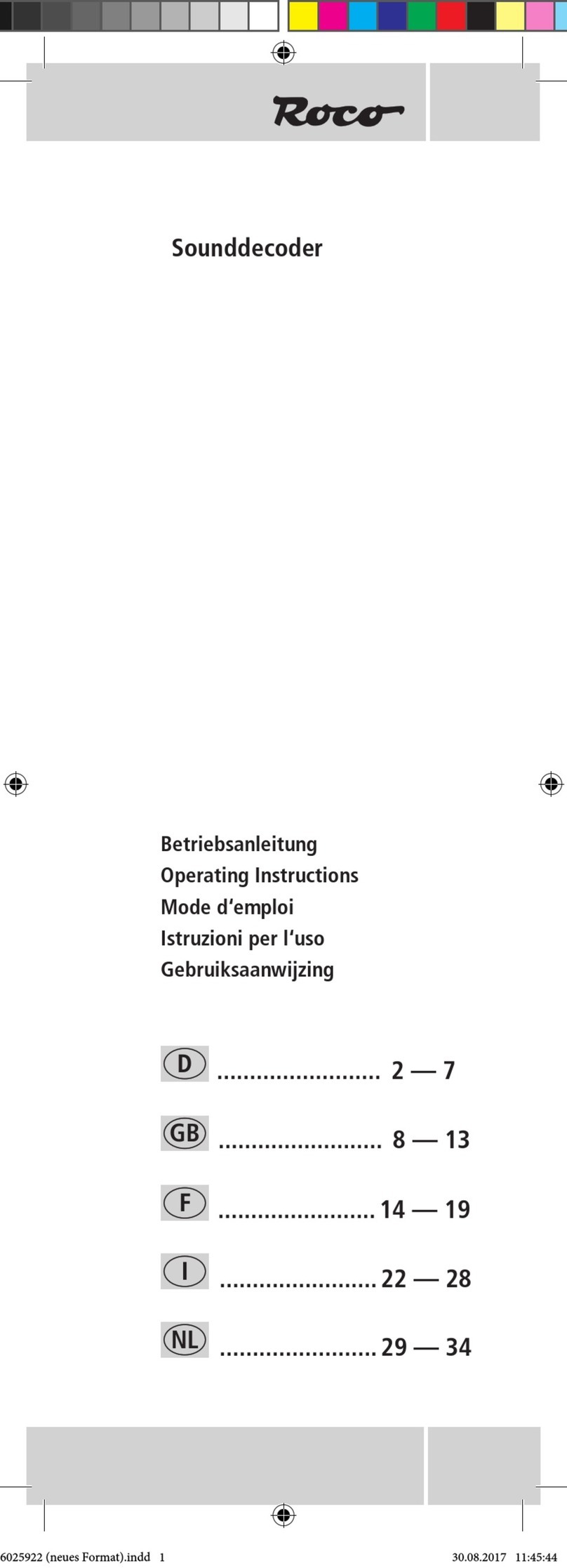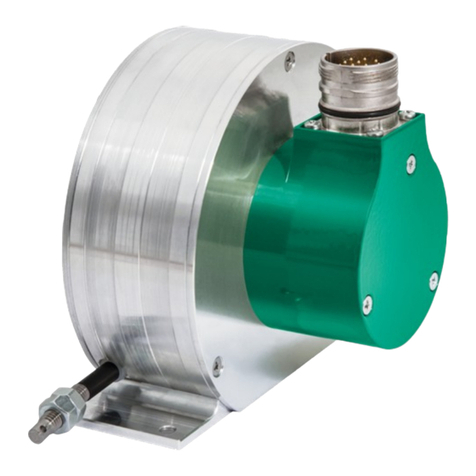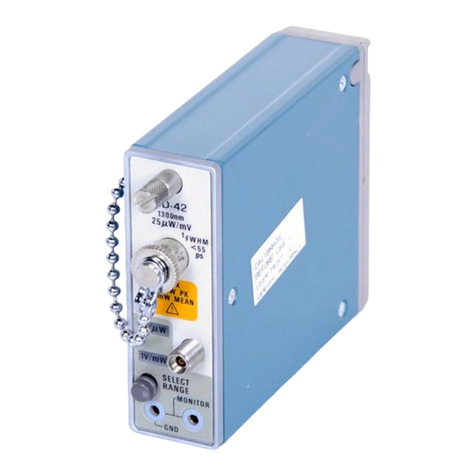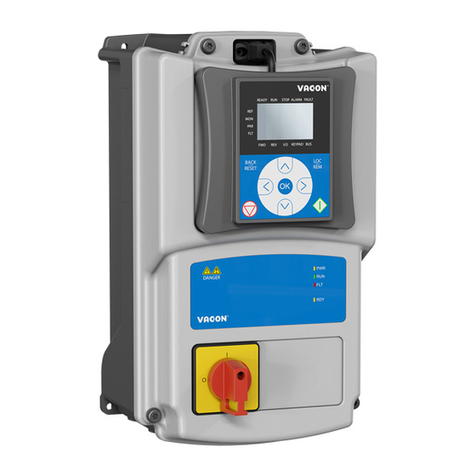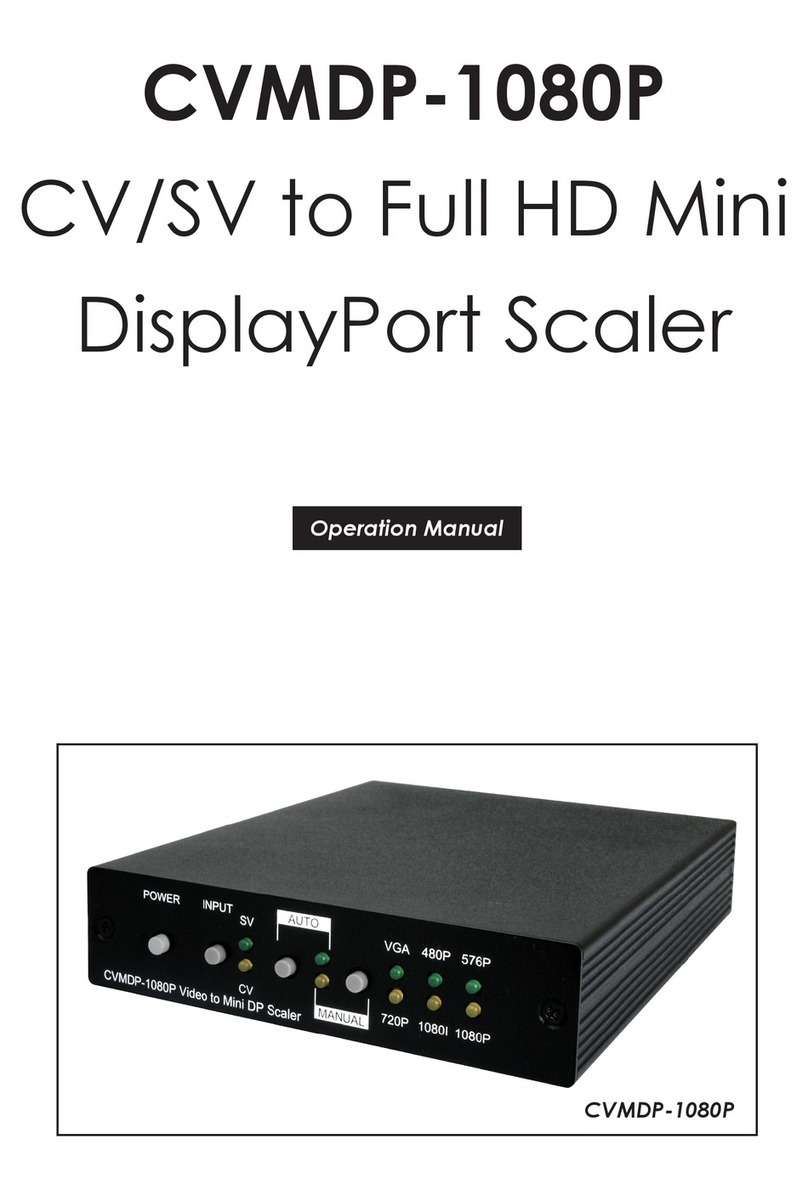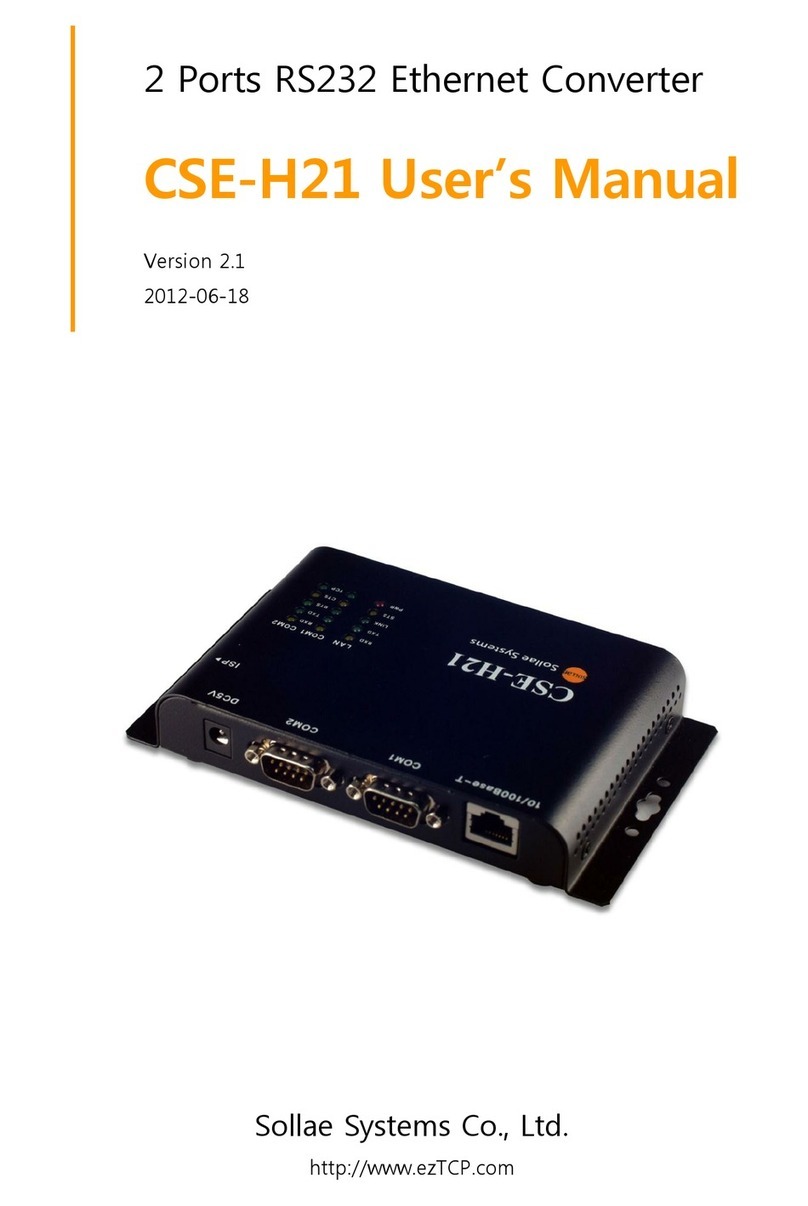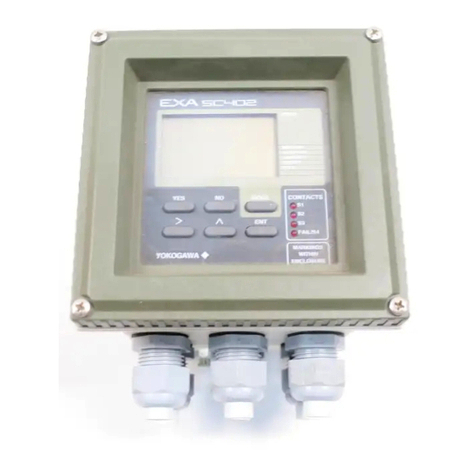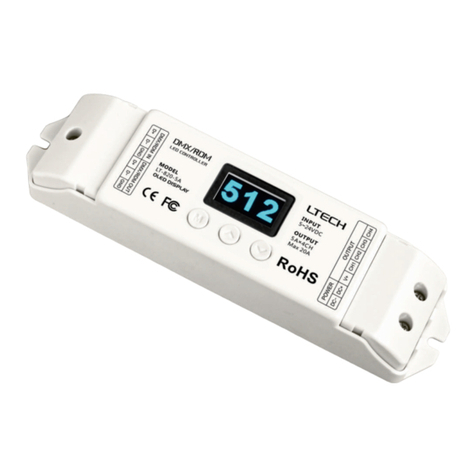roco 40411 User manual

Multiprotokoll-Lokdecoder
mit Entkupplungsfunktion und
RailCom1)
Multiprotokoll Decoder (DCC)
with remote controlled couplings
and RailCom1)
Décodeur numérique «traction»
(format DCC) avec sortie «attelage
télécommandé» et RailCom1)
Inhaltsverzeichnis
Table of Contents
Table des mati�res
D................................. 2
GB ................................. 10
F................................. 18
40411
8040411920 VI_2013.indd 1 19.06.2013 12:42:17

2
D
Wichtige Hinweise:
▪ Digitale Decoder sind hochwertige Erzeugnisse moderner Elektronik und mit
besonderer Sorgfalt zu behandeln:
▪ Berührung mit Flüssigkeiten (z. B. Öl, Wasser, Reinigungsmittel …) gefährden den
Decoder.
▪ Unsachgemäße Behandlung mit metallischen Gegenständen (z. B. Schraubendre-
her, Pinzette…) kann den Decoder mechanisch/elektrisch schädigen.
▪ Grobe Behandlung (z.B. Ziehen an Litzen, Bauteile biegen) kann mechanische/
elektrische Schäden verursachen.
▪ Löten am Decoder kann zum Ausfall führen.
1) RailCom ist ein eigetragenes Warenzeichen der Lenz GmbH, Giessen
2) Märklin ist ein eingetragenes Warenzeichen der Gebr. Märklin & Cie. GmbH, Göppingen
3) Motorola ist eine eingetragenes Warenzeichen der Motorola Inc., Tempe-Phoenix/Arizona
(USA)
Technische Daten
Adressen: 1– 9999 (Lange DCC Adresse)
Max. Motorstrom / Gesamtbelastung des Decoders: 1A
Funktionsausgänge (einzeln und in Summe): je 0,8A
Größe: 20,0 x 11,0 x 3,5 mm
Der Decoder ist voreingestellt auf die Adresse 03, im Betrieb mit 28 Fahrstufen kann im DCC-
und Motorola
3)
-Datenformat gefahren und programmiert werden.
Decoder-Schutz:
▪ Temperatur – Schutz bei 100°C schaltet der Decoder ab und die Lampen blinken schnell.
▪ Kurzschluss – Überwachung der Motor- und Funktionsanschlüsse.
8040411920 VI_2013.indd 2 19.06.2013 12:42:17

3
D
Eigenschaften des Decoders auf einen Blick
▪
Multiprotokollbetrieb möglich (Motorola
3)
Digital, AC Analog, DCC Digital, DC Analog)
▪
Motorregelung
▪
Motorfrequenz: 20 kHz
▪
Unterstützung von Bremsstrecken
▪
128, 28, oder 14 Fahrstufen bei DCC-Betrieb, 14 Fahrstufen bei Motorola
3)
-Betrieb
▪
Lokadressen programmierbar
▪
NMRA-kompatibel
▪
Komfortable Änderung der Betriebsparameter möglich: die Lok muss nicht geöffnet werden
▪
Richtungsabhängige Beleuchtung
▪
Rangiergang per Tastendruck (F3 - halbe Geschwindigkeit)
▪ Beschleunigung und Verzögerungen ausschalten per Tastendruck (F4)
▪
Überstromgeschützt
▪
RailCom
1)
▪ Update-fähig
F1: Sonderfunktion Entkupplung (= grünes Kabel)
F2: Sonderfunktion Entkupplung (= violettes Kabel)
F3: Rangiergang (= halbe Geschwindigkeit)
F4: Beschleunigungs- und Verzögerungswerte deaktivieren
Betriebsarten
▪ Digitaler Mehrzugbetrieb (DCC) mit NMRA-konformen Systemen wie:
—
multi
MAUS (Art.-Nr. 10810)
— Lokmaus 2, Lokmaus R3 (Art.-Nr. 10760, 10860, 10790 und 10792)
— ROCOMOTION (Art.-Nr. 10785)
— Fleischmann TWIN CENTER (Art.-Nr. 6802)
— Fleischmann Profi Boss (Art.-Nr. 6866)
▪Digital (Märklin*- Motorola** alt, Märklin*- Motorola** neu, Delta) Analog- Wechselstrom.
Sie können für das Märklin*- Motorola**-System unter anderem folgende Steuergeräte nut-
zen:
— Märklin* control unit 6021,
— Märklin* control unit 6020 mit Fahrgeräten control 80 oder 80f,
— Märklin* Mobile Station und Central Station
— Uhlenbrock Intellibox (als AC-Regler definiert, mit Motorola**-konformen Adressen).
— ESU ECoS
▪Sie können im Deltabetrieb bei umprogrammierten Adressen auf 24, 60, 72 oder 78 mit einge-
schaltetem Licht fahren. Bitte beachten Sie, dass beim Stillstand – Delta-System-bedingt – das
Licht ausgehen kann. Das Licht ist nur eingeschlatet, wenn CV 51 bit 2 entsprechend einge-
stellt ist. Ab Werk ist das Licht ausgeschaltet. Im Deltabetrieb ist keine Kupplungsfunktion
möglich.
▪Lokomotiven mit werkseitig ausgerüsteter Schnittstelle gemäß NMRA S 9.1./9.2. und NEM
650/652
8040411920 VI_2013.indd 3 19.06.2013 12:42:17

4
D
Einbau (nur notwendig, wenn Sie den Decoder einzeln gekauft haben)
Achten Sie auf die Gefahr von elektrostatischen Entladungen. Sollten Sie ESD (Electrosta-
tic Discharge) Ausrüstung besitzen verwenden Sie diese. Ansonsten achten Sie darauf die
Pins des Steckers nicht zu berühren!
Alle Einbauarbeiten müssen grundsätzlich an vom Gleis genommenen Fahrzeugen erfolgen. Das
Triebfahrzeug muss sich in einwandfreiem mechanischen und elektrischen Zustand befinden: Ver-
schleißteile wie z.B. Motorbürsten, Radkontakte etc. müssen gereinigt oder gegebenenfalls erneu-
ert werden!
Beachten Sie bitte auch die den ROCO-Lokomotiven mit Decoder-Schnittstelle beigefügten
Einbauhinweise!
Wir empfehlen, unter Berücksichtigung der lokspezifischen Einbauanleitung, folgende Vorgehens-
weise:
1. Fahrzeuggehäuse abnehmen und den eventuell bereits vorhandenen Decoder aus der Schnitt-
stelle abziehen.
2. Stecker des Decoders so in die Schnittstelle einsetzen, dass sich die Seite des Decoderste-
ckers mit dem rot/orangen Kabel an der mit + oder ✭markierten Seite der Schnittstelle befin-
det (Polung gemäß NMRA/NEM-Regeln, d.h. Lok fährt mit Führerstand 1 voraus).
3. Den Decoder an einem geeigneten Platz in der Lokomotive unterbringen. Teile des Deco-
ders dürfen dabei nicht mit Metallteilen des Fahrzeuges in Berührung kommen! Eventuell
sollte zum Schutz des Decoders der Einbauplatz mit Isolierband isoliert werden. Dabei ist die
Isolierung an den Metallteilen des Fahrzeuges vorzunehmen, keinesfalls am Decoder selbst
(etwa durch Umwickeln des Decoders mit Isolierband!). Dies kann zu Ausfällen des Decoders
durch thermische Überlastung führen! Reklamationen, die darauf zurückzuführen sind, kön-
nen nicht anerkannt werden!
Der werkseitig verwendete Schrumpfschlauch um den Decoder behindert eine ausreichende
Wärmeableitung nicht und sollte daher nicht entfernt werden.
4. Falls notwendig, kann der Decoder in der Lok mit Doppelklebeband in der gewünschten Lage
fixiert werden.
Achtung: Der Einsatz in anderen Digital-Systemen als den vorstehend aufgelisteten oder
die Verwendung in Triebfahrzeugen, die ab Werk nicht mit einer Decoder-Schnittstelle
nach NMRA oder NEM (siehe oben) ausgestattet sind (Anpassung z.B. durch Abschnei-
den des Schnittstellensteckers und direktes Einlöten der Decoder in das Fahrzeug), kann
zu irreparablen Schäden am Decoder oder an den betreenden Triebfahrzeugen führen.
ROCO kann im Schadensfall weder für den Decoder noch für die betreenden Triebfahr-
zeuge haftbar gemacht werden oder Garantie leisten! Schäden durch sonstige Verände-
rungen am Decoder (wie z.B. Lackieren) sind ebenfalls von der Garantie ausgeschlossen.
Die Verwendung von 12 V-Lampen im Digitalbetrieb kann zu irreparablen Schmelzschä-
den am Fahrzeuggehäuse führen!
Eingebaute 12 V-Lampen müssen gegen 16 V-Lampen ausgetauscht werden (bei Fahrzeugen ab
Produktionsjahr 2000 bereits eingebaut). 16 V-Lampen sind über den guten Fachhandel oder
unsere Service-Abteilung erhältlich. Vergleichen Sie zur vorhandenen Lampenausführung auf dem
Lok-Ersatzteilblatt:
Art.-Nr. 108616 Drahtlampe weiß 16 V ersetzt Art.-Nr. 93520 mit 12 V
Art.-Nr. 109918 Drahtlampe rot (ausschließlich 16 V-Version)
Art.-Nr. 109088: Steckbirnchen klein 16 V, ersetzt Art.-Nr. 93518 mit 12 V
Art.-Nr. 93734: Sotte 16 V, ersetzt Art.-Nr. 93517 mit 12 V
8040411920 VI_2013.indd 4 19.06.2013 12:42:17

5
D
Funktionstest
Bitte beachten Sie, dass die bei Ihrer Zentrale/ihrem digitalen Fahrregler eingestellten Fahrstufen
mit jenen des Decoders (CV29) übereinstimmen müssen.
Ein Blinken der Lichter deutet auf eine falsche Fahrstufeneinstellung hin.
Zum Beispiel wenn der Decoder auf 14 Fahrstufen-Betrieb eingestellt wurde, die Steuerung (
multi-
MAUS etc.) jedoch auf 28 Fahrstufen eingestellt ist. In diesem Fall sollte die CV29 auf den Wert „6“
(= Analogerkennung + FS 28) programmiert werden.
multi
MAUS: Menü „PROGRAMMIEREN (2)“, CV ÄNDERN (2.1.) „CV29“ aufrufen, Wert „6“
eingeben und mit der „Licht/OK“-Taste bestätigen.
Lokmaus 2/ R3: „P“ + „Stop“ gleichzeitig drücken, Meldung „06“ mit „P“ bestätigen.
Falls die Lokbeleuchtung nicht funktioniert, wurde der Decoderstecker beim Einbau verdreht in die
Schnittstelle eingesetzt. Stecken Sie diesen um 180° gedreht wieder ein.
Fahrzeugadresse
Der Decoder ist ab Werk auf die Adresse 03 eingestellt. Zum Programmieren einer anderen Adresse
beachten Sie bitte die entsprechenden Kapitel in den
multi
MAUS/Lokmaus-Handbüchern, bzw. die
Anleitung Ihrer Digital-Anlage!
In der CV1 können nur Lokadressen von 1–99 gespeichert werden. Mit der ROCO
multi
MAUS (Art.-
Nr. 10810) ist die Programmierung von Lokadressen ab 100 („lange Adressen“) möglich*. Zusätzlich
ist es notwendig, das Bit 5 (= 32) in der CV29 einzuschalten, bevor Sie die lange Adresse programmieren.
*
multi
MAUS: Menü „PROGRAMMIEREN (2)“, „LANGE ADRESSE“ (2), Adresse eingeben und mit
der „Licht/ OK“-Taste bestätigen.
Betrieb auf Analog-Anlagen
Eine mit diesem Decoder ausgerüstete Lok können Sie auch auf einer konventionellen Anlage
einsetzen: Zum Fahrtrichtungswechsel muss der Regler des Steuergerätes zuerst auf Null gestellt
werden. Erst danach kann die neue Fahrtrichtung gewählt werden. Die Lampenhelligkeit richtet
sich nach der Geschwindigkeit der Lok. Die Lampen sind nicht ausschaltbar, Sonderfunktionen
sind nicht schaltbar. Eine Umprogrammierung voreingestellter Adressen und Eigenschaften ist im
Analogbetrieb nicht möglich.
Betriebsparameter des Decoders
Der Decoder verfügt über eine Reihe von Einstellmöglichkeiten (z.B. seine Adresse), die sein Ver-
halten bestimmen bzw. Rückschlüsse auf sein Verhalten zulassen. Diese Einstellungen sind bzw.
werden in sogenannten CVs (CV = Configuration Variable, siehe Tabelle am Ende dieser Anleitung)
gespeichert. Es gibt CVs, die nur eine einzige Information (sog. „Byte“) speichern, aber auch sol-
che, die 8 Informationseinheiten (Bits) beinhalten. Die Bits werden von 0 bis 7 durchnummeriert.
Bei der Programmierung brauchen Sie diese Kenntnisse. Die Programmierung der CVs kann sehr
einfach mit jedem DCC-Steuergerät vorgenommen werden, das die Programmierung „CV-direkt“
byte- und bitweise beherrscht. Auch die Programmierung einiger CVs über die Register-Program-
mierung ist möglich. Ferner können alle CVs byte-weise auf dem Hauptgleis programmiert wer-
den, soweit ihr Steuergerät diese Art der Programmierung (POM -Program on Main) beherrscht.
(Weitere Informationen zu diesem Thema erhalten Sie in den Betriebsanleitungen der jeweiligen
Digitalsteuergeräte.)
8040411920 VI_2013.indd 5 19.06.2013 12:42:17

6
D
Decoder Reset
Sie können jederzeit die Werkseinstellungen wiederherstellen, wenn Sie einmal nicht mehr weiter
wissen: Programmieren Sie dazu in CV8 den Wert 08.
CV Name Beschreibung Werte-
bereich
Werks-
wert
1 Lokadresse Adresse der Lok DCC:
01 – 127
Motorola
3)
:
01 – 80
3
2 Anfahrspannung Legt die Mindestgeschwindigkeit der Lok
fest
01 – 255 4
3Beschleunigungszeit Je größer dieser Wert, umso mehr Zeit
braucht die Lok zum Beschleunigen
01 – 255 6
4 Bremsverzögerung Je größer dieser Wert, umso mehr Zeit
braucht die Lok zum Abbremsen
01 – 255 2
5 Maximalspannung legt die Höchstgeschwindigkeit der Lok fest 01 – 255 252
6 Mittenspannung legt die Geschwindigkeit der Lok bei mittlerer
Fahrstufe fest
01 – 252 85
7 Versionsnummer Interne Softwareversion des Decoders (nur
lesen), siehe auch CV65
------- -------
8 Hersteller ID NMRA-Identifikationsnummer des
Herstellers Zimo
08 (Reset) 145
17 Lange Adresse Höherwertiges Byte 192 – 231 192
18 Lange Adresse Niederwertiges Byte 0 – 255 128
28 RailCom1) Wahl der RailCom1)-Sende-Funktionen 0 – 3 3
Bit Funktion Wert
0Broadcast aus
Broadcast ein
0
1
1CV-Daten senden aus
CV-Daten senden ein
0
2
CV-Liste
8040411920 VI_2013.indd 6 19.06.2013 12:42:18

7
D
CV Name Beschreibung Werte-
bereich
Werks-
wert
29 Konfigurations-
register
Diverse Einstellungen der Lok, nur relevant im
DCC-Betrieb. Addieren Sie Werte der einzelnen
Funktionen, um den Wert der CV29 zu bestim-
men. Bsp.: 28 Fahrstufen + Analogbetrieb
erlauben = 2 + 4 = 6
00 – 255 14
155 Rangiertaste Nummer der Funktionstaste, die zum
Rangieren die Lok-Geschwindigkeit halbiert
0 – 12
3
156 Verzögerungs-
Deaktivierung
Nummer der Funktionstaste, die in CV3
und CV4 gespeicherten Verzögerungen aus-
schaltet
0 – 12
4
65 Software-Version Unter-Nummer zur in CV7 angezeigten
Nummer der Software-Version des Decoders
Bit Beschreibung Wert
0Normale Fahrtrichtung
Umgekehrtes
Fahrtrichtungsverhalten
0
1
114 Fahrstufen im DCC-System
28 / 128 Fahrstufen im DCC-System
0
2
2Analogbetrieb ausschalten
Analogbetrieb erlauben
0
4
3
RailCom1)-Funktionalität
RailCom1) aus
RailCom1) ein
0
8
43-Punkt-Kennlinie gemäß CV2, CV5
CV6
28-Punkt-Kennlinie gemäß CV67 -
CV94
0
16
5Kurze Adresse (CV1) im DCC-
Betrieb
Lange Adresse (CV17 + CV18) im
DCC-Betrieb verwenden
0
32
8040411920 VI_2013.indd 7 19.06.2013 12:42:18

8
D
Bremsstrecken
Der Decoder beherrscht das automatische Abbremsen in Bremsabschnitten, die nicht digital,
sondern entweder mit Gleichstrom oder mit Wechselstrom(Märklin-Bremsabschnitt) versorgt
werden. Um auf diese Abschnitte zu reagieren, ist der Decoder per CV-Programmierung einzu-
stellen.
Zunächst ist in CV29 der normale Analog-Betrieb auszuschalten, d.h. Bit 2 wird auf Null (0)
gesetzt bzw. vom Gesamtwert der CV (Werkswert war 14) der Wert 4 abgezogen.
Weiterhin ist in CV124 Bit 5=1 (Wert 32) die Bremsstrecken-Erkennung (Gleichstrom) einzuschal-
ten. Wird die Märklin-Bremsstrecke mit Wechselspannung verwendet, ist diese zusätzlich mittels
CV112 Bit 6=1 (Wert 64) einzuschalten.
Besondere Funktionen
Entkuppeln
Nachdem Sie die Lok mit den Kupplungen versehen, können Sie diese vom Decoder aus elektrisch
mit den Funktionstasten F1 und F2 entkuppeln. Mittels der CV116 kann ein „Kupplungs-Walzer“
eingestellt werden, d.h. die Lok kann aus dem Stillstand nach dem Entkuppeln automatisch vom
Wagen abrücken (in gleicher Richtung vom gezogenen Wagen wegfahren) oder auch zusätzlich vor
dem Abkuppeln noch kurz an den Wagen andrücken (d.h. kurz zurück fahren).
CV Name Beschreibung Werte-
bereich
Werks-
wert
116 „Kupplungs-Walzer“ Abrücken: Mit Werten von 0-9 in der Zeh-
ner-stelle wird die Abrück-Zeit für 0-5 sec
eingestellt.
Mit Werten von 0-9 in der Einerstelle (mul-
tipliziert mit 4) wird die Geschwindigkeit
beim Abrücken eingestellt, bezogen auf 128
Fahrstufen.
In der Hunderterstelle kann das automa-
tische Andrücken vor dem Entkuppeln
mit dem Wert 0 aus- und mit dem Wert 1
eingeschaltet werden.
00 – 99
00 – 199
0
CV Name Beschreibung Werkswert
29 Konfigurationsregister Analog-Funktionalität 14
Ändern: 10
124 Spezielle Konfiguration Bremsstrecke 0
Ändern: 32
112 Spezielle Konfiguration Art der Bremsstrecke 0
Ändern: 64
Bit Beschreibung Wert
3Analogbetrieb ausschalten
Analogbetrieb einschalten
0
4
Bit Beschreibung Wert
5Bremsstrecke ausschalten
Bremsstrecke einschalten
0
32
Bit Beschreibung Wert
6Bremsstrecke Gleichsstrom
Bremsstrecke Wechselstrom
0
64
8040411920 VI_2013.indd 8 19.06.2013 12:42:18

9
D
Falls weitere CV’s programmiert werden sollen, Punkt 5-9 wiederholen.
Wenn die Programmierung beendet werden soll, die Zentrale auf „STOP“ schalten oder die Adres-
se „80“ einge-ben und kurz die Fahrtrichtungsumschaltung betätigen.
Da bei der Programmierung mit einer Motorola3) Digitalzentrale von Märklin2) nur Eingaben von 01
bis 80 möglich sind, muss der Wert „0“ über die Adresse als „80“ eingegeben werden.
Programmieranleitung für Märklin
2)
6020/6021
Mit einer Märklin
2)
Zentrale können alle CV’s programmiert, aber nicht ausgelesen werden.
▪ Der Fahrregler muss auf „0“ stehen.
▪Ausser der zu programmierenden Lokomotive darf sich keine weitere Lok auf den Gleisen befin-
den!
▪ Beachten Sie beim Programmieren die Blinksignale der Lokbeleuchtung.
▪Solange sich der Decoder im Programmiermodus befindet, können beliebig viele Änderungen/
Einstellungen vorgenommen werden.
1. STOP und GO Taste gleichzeitig drücken, bis ein Reset ausgeführt wird
2. STOP Taste zum Abschalten der Schienenspannung
3. Adresse 80 eingeben
4. Fahrtrichtungsumschalter drücken und gedrückt halten, dann zusätzlich GO für mind. 0,5
sek. drücken, um Schienenspannung wieder einzuschalten
5. Dekoder ist im Programmiermodus =Langsames Blinken
6. Eingabe des zu ändernden Registers (zweistellig im Adressfeld)
7. Zur Bestätigung Fahrtrichtungsumschalter drücken =Schnelles Blinken
8. Gewünschten Wert eingeben (zweistellig im Adressfeld)
9. Zur Bestätigung Fahrtrichtungsumschalter drücken =Langsames Blinken
Programmieranleitung für Märklin* „Mobile Station“ und
„Central Station“
▪ Ausser der zu programmierenden Lokomotive darf sich keine weitere Lok auf den Gleisen
befinden!
1. ESC-Taste drücken
2. Menüpunkt „Neue Lok“ auswählen
3. Menüpunkt „Datenbank“ auswählen
4. Mit dem Drehknopf die Artikelnummer „36330“ auswählen
5. Noch einmal die ESC-Taste an der Mobile Station drücken
6. Menüpunkt „Lok ändern“ auswählen
7. Im Menüpunkt „Adresse“ kann die Märklin*-Adresse ausgewählt werden
8. Im Menüpunkt „Name“ kann der Name der Lok geändert werden
Die Funktionen F1– F4 können mit den 4 linken Tasten der Mobile Station aufgerufen werden.
Dabei entspricht die oberste Taste der Funktion F1. Die aktivierten Funktionen können aber nicht
im Display angezeigt werden.
Sollte die Programmierung ausnahmsweise auch nach einem zweiten Versuch nicht erfolgreich
gewesen sein, fürhen Sie bitte einen Decoder -Reset durch, programmieren Sie dazu CV8 auf den
Wert 08!
Hinweis: Weitere Funktionen zu diesem Decoder finden Sie unter www.zimo.at
8040411920 VI_2013.indd 9 19.06.2013 12:42:18

10
GB
Technical Data
Addresses: 1– 9999 (long DCC address)
Max. engine current / total load: 1 A
Function outputs (each and in total): 0,8A each
Dimensions: 20,0 x 11,0 x 3,5 mm
The decoder is preset at Address 03 with operating in 28 driving stages and can be driven
and programmed in DCC and Motorola
3)
data format.
Decoder protection:
▪Temperature protection the decoder deactivates and the lights flash rapidly at 100°C.
▪ Short circuit monitoring of the motor and function connections.
1) RailCom is a registered trademark of the company Lenz GmbH, Giessen
2) Märklin is a registered trademark of the company Gebr. Märklin & Cie. GmbH, Göppingen,
Germany
3) Motorola is a registered trademark of the company Motorola lnc.,Tempe-Phoenix/Arizona
(USA)
Important instructions:
▪ Digital decoders are modern high-quality electronic products and are to be treated with
special care:
▪ Coming into contact with fluids (e.g. oil, water, cleaning agents …) place the decoder
at risk.
▪ Incorrect treatment with metallic objects (e.g. screwdriver, tweezers…) can cause
mechanical/electrical damage to the decoder.
▪ Rough treatment (e.g. pulling wire strands, bending components) can cause mecha-
nical/electrical damage.
▪ Soldering work on the decoder can result in failures occurring.
8040411920 VI_2013.indd 10 19.06.2013 12:42:18

11
GB
Receiver Module Features at a Glance
▪ Multiprotocol operation possible
(Motorola
3)
Digital, AC Analogue, DCC Digital, DC Analogue)
▪ Engine control
▪ Engine frequency: 20 kHz
▪ Support of braking distances
▪ 128, 28 or 14 driving stages in DCC operation, 14 driving stages in Motorola
3)
operation
▪ Programmable locomotive addresses
▪ NMRA-compatible
▪ The operating parameters can be comfortably changed: the locomotive does not have to be
opened
▪ Direction-related lighting
▪ Shunting at the push of a button (F3 – half speed)
▪ Acceleration and delay deactivation at the push of a button (F4)
▪ Overload protection
▪
RailCom
1)
▪
Can be updated
F1: Special function (= green wire)
F2: Special function (= violet wire)
F3: Shunting mode (= half speed)
F4: Deactivate set values for braking or acceleration
Operating Modes
▪ Digital multi-train operation with NMRA compatible systems as:
—
multi
MAUS (art. no. 10810)
— Lokmaus 2, Lokmaus R3 (art. no. 10760, 10860, 10790 and 10792)
— ROCOMOTION (Art.-Nr. 10785)
— Fleischmann TWIN CENTER (art. no. 6802)
— Fleischmann Profi Boss (art. no. 6866)
▪ Analog alternating current, digital ( Märklin*- Motorola** old, Märklin*- Motorola** new,
Delta): For the Motorola** system the following control equipment may be used:
— Märklin* control unit 6021,
— Märklin* control unit 6020 with speed controllers control 80 or 80f,
— Märklin* Mobile Station and Central Station
— Uhlenbrock Intellibox (configured as AC controller, with Motorola** conforming ad-
dresses).
— ESU ECoS
▪ In Delta operation reprogrammed addresses 24, 60, 72 or 78 you can run with lights turned
on. Please note that when stopping – Delta system characteristic – the lights may turn o..
The light is only switched on if CV 51 bit 2 has been set accordingly. The light is switched o
by the manufacturer. The coupling function is not available in delta operation.
▪ H0 DC locomotives with a decoder interface according to NMRA S 9.1/9.2 and NEM
650/652
8040411920 VI_2013.indd 11 19.06.2013 12:42:18

12
GB
The use of this decoder in other than the previously listed digital systems or in power units
which are not factory-equipped with NMRA or NEM (see above) conforming decoder
interfaces (installation by e.g. cutting the interface plug and soldering of the decoder
into the locomotive) can cause irreparable damage to the decoder or the locomotive.
ROCO cannot be held liable in such events for the decoder or the locomotive or any
guarantee. Damage caused by any other changes to the decoder (e.g. applying paint) are
also excluded from any guaranties.
The use of 12 volt bulbs during digital operation can cause irreparable damage (melting)
to the locomotive housing!
Installed 12 volt bulbs must be changed to 16 volt bulbs (already installed in locomotives starting
with fabrication year 2000). 16 volt bulbs can be obtained through stockists or our service
department. Compare with the installed bulb shown in the locomotive replacement parts listing:
art.no. 108616: bulb with attached leads, white 16 V replaces art.no. 93520 12 V
art.no. 109918: bulb with attached leads, red (only 16 volt version)
art.no. 109088: plug-in bulb, small 16 V, replaces art.no. 93518 12 V
art.no. 93734: tubular bulb 16 V, replaces art.no. 93517 12 V
Installation (required only if decoder was bought separately)
Take precautions to protect against hazardous static discharges. If you have ESD (electro-
static discharge) equipment available, then use it. Otherwise make sure that you do not
touch the pins on the connector!
All installation work must be done on vehicles removed from the track. The locomotive must be
in perfect electrical and mechanical condition. Parts subject to wear e.g. motor brushes, wheel
contacts, have to be cleaned or replaced!
Please note the installation instructions provided with all ROCO locomotives having decoder
interfaces !
We recommend, in addition to the specific locomotive installation instructions, the following
procedure:
1. Remove housing and detach the reversing module or the already installed decoder from the
interface.
2. Insert the decoder plug into the interface so that side of the decoder plug with red/orange wire
at the side of the interface marked with + or ✭ (polarity according to NMRA/NEM rules, i.e.
the locomotive moves with the driver’s cab no.1 facing forward).
3. Install the decoder in a suitable location within the locomotive. No part of the decoder must
be touching metal parts of the locomotive! If necessary the location of the decoder must be
insulated with insulation tape to protect the decoder. The insulation must be attached to the
metal parts of the locomotive, but NOT to the decoder (e.g. by winding the insulation tape
around the decoder!). This could lead to failure of the decoder due to overheating. Damage
claims caused by such failures cannot be acceptet!
The factory used heat shrink tubing around the decoder ensures a sucient heat dissipation
and should not be removed.
4. If necessary the decoder can be secured in the desired location with double-sided tape.
8040411920 VI_2013.indd 12 19.06.2013 12:42:18

13
GB
Operating parameters for the decoder
The decoder has numerous setting possibilities (e.g. its address) which determine its actions or
enable conclusions to be drawn concerning its actions. These settings are or will be stored in
so-called CVs (CV = Configuration Variable, please refer to the table at the end of these instruc-
tions). There are CVs which only store a single piece of information (referred to as a “byte”), and
others which include 8 information units (bits). The bits are numbered in sequence from 0 to 7.
You require this knowledge for the programming. The programming of the CVs can be very easily
carried out with a DCC control device which is able to program “CV-direct” in bytes and bits. The
programming of some of the CVs is also possible via the register programming. All of the CVs can
also be programmed on the main track in bytes as long as your control device is able to carry out
this programming form (POM -Program on Main). (You will find more information on this subject
in the operating instructions for the digital control device concerned).
Operational test
Please ensure that the driving stages set in your central unit/digital driving controller are the same
as those in the decoder (CV29).
Flashing lights indicate an incorrect driving stage setting.
For example, if the decoder has been set to 14 driving stage operation but the control (multiMOUSE,
etc.) has been set to 28 driving stages. In this case, the CV29 should be programmed with the value
“6“ (= analogue detection + FS 28) .
multiMAUS: Menu “PROGRAMMING (2)“, CHANGE CV (2.1.) call up “CV29“, enter the value “6“
and activate with the “Light/ OK“ key.
Locmouse 2/R3: Press “P“ + “Stop“ at the same time, confirm message “06“ with “P“.
If the locomotive lights do not operate, the decoder was inserted incorrectly into the interface.
Reinsert decoder turned by 180° in the interface.
Locomotive address
The decoder is set to the Address 03 by the manufacturer. For information on programming a dierent
address, please refer to the corresponding chapter in the multiMOUSE/locomotive mouse manuals
or the instructions for your digital system!
Only locomotive addresses between 1 and 99 can be stored in CV1. The programming of locomotive
addresses over 100 (“long addresses“) is possible with the ROCO multiMOUSE (Art. No. 10810)*. It
is also necessary to activate Bit 5 (= 32) in the CV29 before programming long addresses.
multiMAUS: In menu “PROGRAMMING (2)“, “LONG ADDRESS“ (2), enter the address
and confirm with the “Light/OK“ key.
Operation on analog layouts
You can also use a locomotive which is equipped with this decoder, with a conventional system:
a change in the direction of travel is only possible after the controller of the control device has
been set to zero. Only then is it possible to select the new direction of travel. The lamp brightness
depends on the speed of the locomotive. The lamps cannot be switched o and special functions
cannot be additionally activated. A reprogramming of preset addresses and features is not possible
in analogue operation.
8040411920 VI_2013.indd 13 19.06.2013 12:42:18

14
GB
CV-Liste
CV Name Description Value
Range
Works
Value
1 Locomotive
address
Address of the locomotive DCC
01 – 127
Motorola
3)
01 – 80
3
2 Start-up voltage Determines the slowest locomotive speed 01 – 255 4
3 Acceleration time The higher this value, the more time the
locomotive takes to accelerate
01 – 255 6
4 Braking
deceleration
The higher this value, the more time the
locomotive takes to brake
01 – 255 2
5 Maximum voltage Determines the fastest locomotive speed 01 – 255 252
6 Average voltage Determines the locomotive speed in the
middle driving stage
01 – 252 85
7 Version number Internal software version of the decoder
(only reading)
------- -------
8 Manufacturer ID NMRA identification number from the manu-
facturer Zimo.
08 (Reset) 145
17 Long address High-value byte 192 – 231 192
18 Long address Low-value byte 00 – 255 128
28 RailCom1) Selecting the RailCom1) transmission
functions
00 – 3 3
Decoder Reset
Should you not know what to do at any time, you can restore the works settings at all times: simply
program the value 08 in the CV 8.
Bit Function Value
0Broadcast off
Broadcast on
0
1
1Transmitting the CV data off
Transmitting the CV data on
0
2
8040411920 VI_2013.indd 14 19.06.2013 12:42:18

15
GB
CV Name Description Value
Range
Works
Value
29 Configuration
register
Diverse locomotive settings, only relevant in DCC
operation. Add the values of each of the functions
to determine the value of the CV29
Bsp.: 28 driving stages + permit analogue
operation = 2+4 = 6.
0 – 255 14
155 Shunting key Number of the function key which is used to
decelerate the locomotive speed by half for
the purpose of shunting
0 – 12 3
156 Delay deactivation Nnumber of the function key which deac-
tivates the delays which are stored in CV3
and CV4
0 – 12 4
65 Software-Version Sub-number of the number of the software
version of the decoder as displayed in CV7
Bit Function Value
0Normal direction of travel
Direction reversal
0
1
114 driving stages in DCC system
28 / 128 driving stages in DCC
system
0
2
2Deactivate analogue operation
Activate analogue operation
0
4
3RailCom1) off
RailCom1) on
0
8
43-point characteristic line in
accordance with CV2, CV5, CV6
28-point characteristic line in
accordance with CV67 -CV94
0
16
5Use short address (CV1) in DCC
operation
Long address (CV17+18) in DCC
operation
0
32
8040411920 VI_2013.indd 15 19.06.2013 12:42:18

16
GB
Braking distances
The decoder is able to automatically brake the locomotive in brake sections which are not digital,
but which are either supplied with a direct current or with an alternating current (Märklin brake
section). The decoder is to be adjusted with CV programming before a reaction to these sections
is possible.
First of all, the normal analogue operation has to be deactivated in CV29, i.e. Bit 2 is set at zero
(0) or the value 4 is deducted from the total value of the CV (the works value was 14).
The braking distances detection (direct current) also needs to be activated in CV124 Bit 5=1
(value 32). If the Märklin braking distance with alternating current should be used, this is to be
additionally activated using CV112 Bit 6=1 (value 64).
Special Functions
Decoupling
This locomotive is fitted with couplers which can be electrically decoupled from the decoder. Both
of the couplers are activated simultaneously using the F1 function key. The CV116 can be used to
adjust a “coupling roller“, i.e. when at a standstill, the locomotive is able to automatically move
away from the carriage (commence travel in the same direction as the carriage which is being pul-
led) or it can also be briefly pushed against the carriage (e.g. travel in reverse briefly).
CV Name Description Value
Range
Works
Value
116 “Coupling roller“ Moving away: the moving away duration is
set for 0-5 sec by means of values of 0-9 in
the decimal position.
The moving away speed is set with values
of 0-9 in the unit position (multiplied by 4),
based on 128 driving stages.
The automatic pushing before decoupling
can be deactivated in the hundreds positi-
on with the value 0 and activated with the
value 1.
00 – 99
00 – 199
0
CV Name Description Works Value
29 Configuration register Analogue functionality 14
change: 10
124 Special configuration Braking distance 0
change 32
112 Special configuration Type of braking distance 0
change: 64
Bit Function Value
3Deactivate analogue operation
Activate analogue operation
0
4
Bit Function Value
5Deactivate braking distance
Activate braking distance
0
32
Bit Function Value
6Direct current braking distance
Alternating current braking
distance
0
64
8040411920 VI_2013.indd 16 19.06.2013 12:42:18

17
GB
Programming instructions for the Märklin
2)
6020/6021
A Märklin
2)
centre can be used to program all of the CVs but they cannot be read out.
▪ The controller has to be set to “0“.
▪ No locomotives are to be on the tracks except the one which is to be programmed!
▪ Please observe the locomotive lighting flashing signals during programming.
▪ Any number of changes/settings can be made as long as the decoder is in programming mode.
1. Press the STOP and GO buttons at the same time until a reset is carried out
2. STOP button until deactivation of the track voltage
3. Enter address 80
4. Press the direction of travel switch and keep it pressed in and then additionally press GO
for at least 0.5 sec in order to reactivate the track voltage
5. The decoder is in programming mode = slow flashing
6. Enter the register which is to be changed (two figures in the address field)
7. Confirm by pressing the direction of travel switch = rapid flashing
8. Enter the required value (two figures in the address field)
9. Confirm by pressing the direction of travel switch = slow flashing
If you wish to program additional CVs, repeat numbers 5.-9.
To stop the programming, switch the centre to “STOP“ or enter the address “80“ and briefly acti-
vate the direction of travel change.
As a Motorola
3)
Digital Centre from Märklin
2)
can only be programmed by entering numbers bet-
ween 01 and 80, the value “0“ has to be entered via the address as “80“.
Note: You will find additional functions for this decoder at www.zimo.at
1. Press the ESC button
2. Select the menu item “New Loc“
3. Select the menu item “Database“
4. Select the article number “36330“ with the rotary knob
5. Press the ESC button
6. Move to menu option (Change Locomotive”) with the knob
7. Choose menu option (“Address”)
8. Choose menu option (“Name”)
Programming with the Märklin
2)
Mobile Station:
1. Press the “ESC“ button
2. Turn the rotary controller to the right until you reach menu item “CHANGE LOC“
3. Turn the rotary controller 2x to the left until you reach menu item “REG“
4. Turn the rotary controller until the required CV address flashes
5. Turn the rotary controller until the required CV value flashes
The decoder confirms the programming with a slight movement at the engine.
Programming instructions for the Märklin
2)
“Mobile Station“ and “Central Station“
▪ No locomotives are to be on the tracks except the one which is to be programmed!
8040411920 VI_2013.indd 17 19.06.2013 12:42:18

18
F
Caractéristiques techniques
Adresses : 1– 9999 (Adresse DCC longue)
Puissance max. sur moteur/Charge totale : 1 A
Sorties de fonction (individuelles et somme) : resp. 0,5A
Taille : 20,0 x 11,0 x 3,5 mm
Le décodeur est préconfiguré sur l’adresse 03, 28 paliers de vitesse et peut être programmé et
utilisé dans les formats DCC et Motorola
3)
.
1) RailCom est une marque déposée de la société Lenz GmbH, Giessen
2) Märklin est une marque déposée de la société Gebr.Märklin & Cie. GmbH, Göppingen
3) Motorola est une marque déposée de la société Motorola lnc.,Tempe-Phoenix/Arizona (USA).
Protection décodeur:
▪Protection thermique à 100°C le décodeur s’éteint et les lampes clignotent rapidement.
▪ Contrôle de court-circuit des connections moteur et fonctions.
Remarques importantes :
▪ Les décodeurs numériques sont des produits électroniques moderne de haute
qualité et doivent donc être employés avec un soin particulier:
▪ Le contact avec des liquides (p. ex. huile, eau, produits de nettoyage …) peut nuire
au décodeur.
▪ Le maniement incorrect des objets métalliques (p. ex. avec un tournevis, une
pincette…) peut nuire mécaniquement/électriquement au décodeur.
▪ Un maniement maladroit (p. ex. des tréfilages de fils, des pliages de pièces) peut
causer les dégâts électriques ou mécaniques.
▪ Une soudure sur le décodeur peut engendrer le disfonctionnement du celui-ci.
8040411920 VI_2013.indd 18 19.06.2013 12:42:18

19
F
Propriétés du module récepteur en un coup d’œil
▪
Exploitation multi-protocoles possible
(Motorola
3)
Digital, AC analogique, DCC digital, DC analogique)
▪
Régulation du moteur
▪
Fréquence du moteur : 18,75 kHz
▪
Assistance des trajectoires de freinage
▪
128, 28 ou 14 crans de marche pour une exploitation format DCC, 14 paliers de vitesse pour une
exploitation format Motorola
3)
,
▪
Adresses de locomotives programmables
▪
Compatible NMRA
▪
Modification aisée des paramètres possible : la locomotive ne doit pas être ouverte
▪
Eclairage en fonction de la direction
▪ Marche manœuvre par actionnement de touche (F3 – demi-vitesse)
▪ Accélération et ralentissement par actionnement de touche (F4)
▪ Overload protection
▪
RailCom
1)
▪
Mise à jour possible
F1: Fonction supplémentaire externe (fil vert)
F2: Fonction supplémentaire externe (violet vert)
F3: Vitesse «manoeuvres» (marche à 50% de la vitesse programmée)
F4: Désactiver les coëfficients de simulation d‘inertie à l‘accélération, à la décélération et au freinage
Régimes de commande
▪ Une commande du décodeur est possible par les unités centrales suivantes:
—
multi
MAUS (ref. 10810)
—LOCO SOURIS (réf. 10760, 10860, 10790 and 10792)
— ROCOMOTION (réf. 10785)
— Fleischmann TWIN CENTER (réf. 6802)
— Fleischmann Profi Boss (réf. 6866)
▪ Courant alternatif analogique, numérique (Märklin*- Motorola** ancien, Märklin*- Motorola**
nouveau, Delta)
Une commande du décodeur est possible par les unités centrales suivantes:
— MÄRKLIN* «control unit 6021»
— MÄRKLIN* «control unit 6020» complétée par les régulateurs «control 80» ou «control 80f»
— MÄRKLIN* Mobile Station et Central Station
— Uhlenbrock Intellibox (si programmée comme centrale numérique «trois rails,
courant alternatif» avec des adresses conformes au protocole «MOTOROLA**»).
— ESU ECoS
▪ Possibilité de faire circuler votre machine à feux éclairés sur un réseau à commande numé-
rique MÄRKLIN*-Delta en utilisant les adresses 24, 60, 72 ou 78. Veuillez tenir compte du fait
qu‘à l‘arrêt les feux peuvent s‘éteindre suite aux caractéristiques techniques de la commande
numérique MÄRKLIN*-Delta. La lumière n’est allumée que si CV 51 bit 2 est allumé de ma-
nière correspondante. Départ usine, la lumière est éteinte. La fonction d’attelage n’est pas
possible en exploitation Delta.
▪ Locomotives H0 pour commande analogique en courant alternatif ou commande numérique
MÄRKLIN*/ MOTOROLA** ancien ou nouveau format de n‘importe quel fabricant, munie,
d‘usine, d‘une interface normalisée NEM 650/652 et d‘un moteur à courant continu.
8040411920 VI_2013.indd 19 19.06.2013 12:42:18

20
F
L‘utilisation du décodeur dans d‘autres systèmes de commande numérique surtout fonction-
nant à d’autres formats que «MÄRKLIN*/MOTOROLA**» énumérés en haut ou celle avec
du matériel moteur non muni d‘interface normalisée NEM 650/652 (ceci en coupant la fiche
du décodeur et soudant ses fils directement aux différents circuits électriques de la machine)
peuvent causer des dommages irréparables au décodeur ou même à la locomotive. ROCO
réfusera alors toute responsabilité et donc toute garantie sur un décodeur ainsi employé ou
modifié. ROCO réfusera également toute garantie au cas où le décodeur sera endommagé
par d‘autres modifications (peinture, enrobage de sa platine par des bandes adhésives, etc.).
ATTENTION : L‘emploi d‘ampoules 12 Volts pour les feux d‘une machine ou pour l‘éclairage
intérieur de vos voitures peut faire fondre le plastique des modèles et causer ainsi de dom-
mages irréparables, étant donné que votre réseau est alimenté en commande numérique
et donc à tension plus élevée!
Des ampoules 12 Volts installés sur votre matériel «traction» ou «remorqué» sont
obligatoire-ment à remplacer par des ampoules «16 Volts». Tous les modèles ROCO sortis à
partir de l‘année 2000 sont équipés d‘ampoules 16 Volts. Les ampoules de rechange «16 Volts»
se trouvent chez votre détaillant spécialisé ou au S.A.V. ROCO. Veuillez comparer les références
d‘ampoules de rechange mentionnées sur la fiche de pièces détachées de votre modèle aux
références mentionnées ci-après :
Réf. 108616: Ampoule incolore 16 V à électrodes (remplace l‘ampoule 12 V à électrodes réf. 93520
);
Réf. 109918: Ampoule rouge 16 V à électrodes (n‘existe qu‘en version 16 V);
Réf. 109088: Petite ampoule enfichable, 16 V (remplace l‘ampoule enfichable, 12 V, réf. 93518);
Réf. 93734: Souffitte 16 V (remplace la souffitte 12 V réf. 93517).
L’installation du décodeur
Veuillez surtout faire attention aux décharges électrostatiques. Si vous disposez d’un
équipement ESD (Electrostatic Discharge = équipement de protection contre les déchar-
ges électrostatiques) il est conseillé de s’en servir lors du montage, sinon veillez surtout à
ne pas toucher les contacts de la fiche de connexion du décodeur !
Toutes les opérations d‘installation sont impérativement à faire la locomotive enlevée des rails.
Elle doit être en bon état général (mécanique, électrique, etc.): Des pièces à usure naturelle
(balais, palpeurs, etc.) sont à nettoyer ou à remplacer, si besoin!
Veuillez également tenir compte des recommandations d‘installation d‘un décodeur fournies avec
les locomotives ROCO munies d‘interface NEM 650/652 !
Tout en respectant les dispositions individuelles d‘installation pour chaque locomotive nous vous
conseillons de procéder comme suit :
1. Déposer la caisse de la locomotive et déconnecter, de l‘interface NEM 650/652 de la locomo-
tive, l‘inverseur électronique ou le décodeur à remplacer.
2. Enficher sur l‘interface la fiche du nouveau décodeur de telle façon que le côté de la fiche marqué
par le fil rouge ou orange se situe côté contact de l‘interface marqué par + ou ✭(polarité du
courant «traction» suivant les normes NEM et NMRA, la machine s‘évoluant cabine 1 ou che-
minée en avant).
3. Placer le décodeur dans la machine. ATTENTION : Aucun composant électronique du décodeur
ne doit se retrouver en contact direct avec un autre composant métallique de la locomotive ! En
vue de protéger le décodeur contre tout contact involontaire il faut éventuellement isoler l‘endroit
prévu à l‘aide d‘une bande adhésive isolante. Dans ce cas, l‘isolation doit être faite aux surfaces
8040411920 VI_2013.indd 20 19.06.2013 12:42:18
Table of contents
Languages:
Other roco Media Converter manuals

